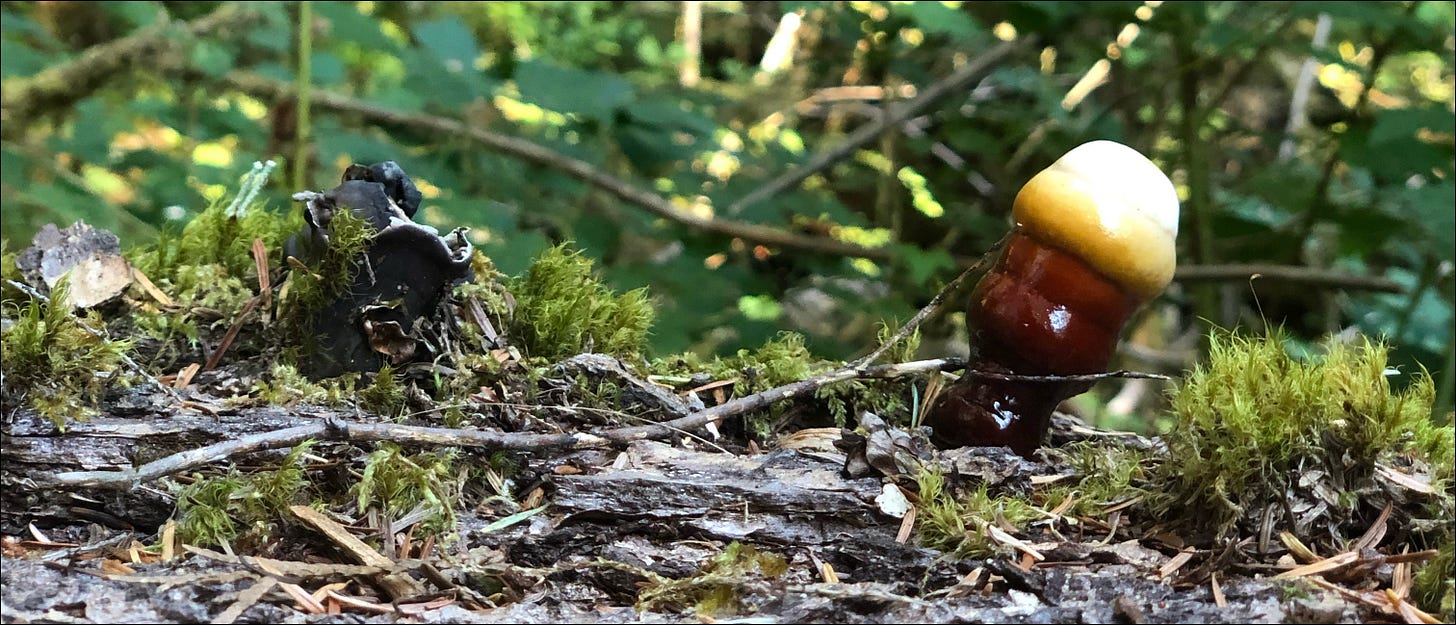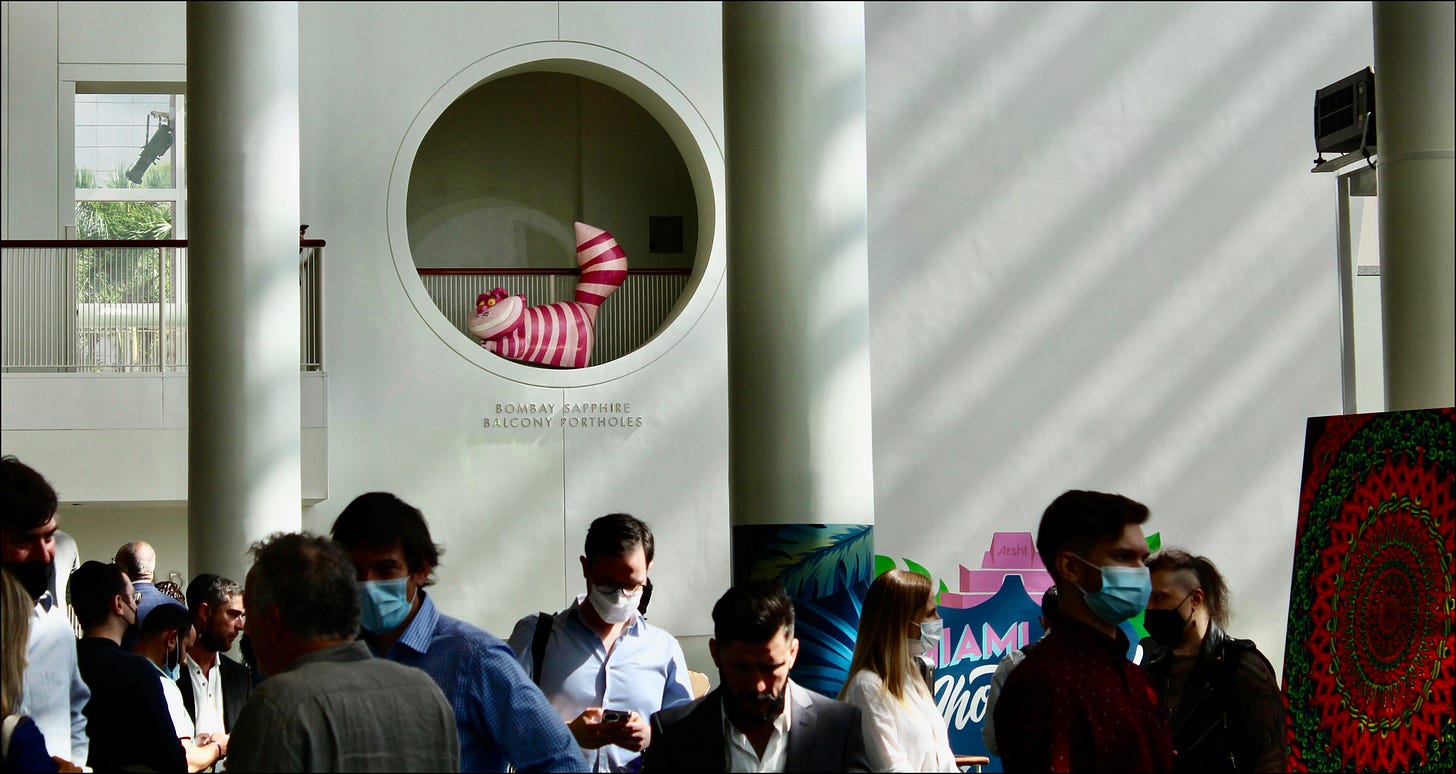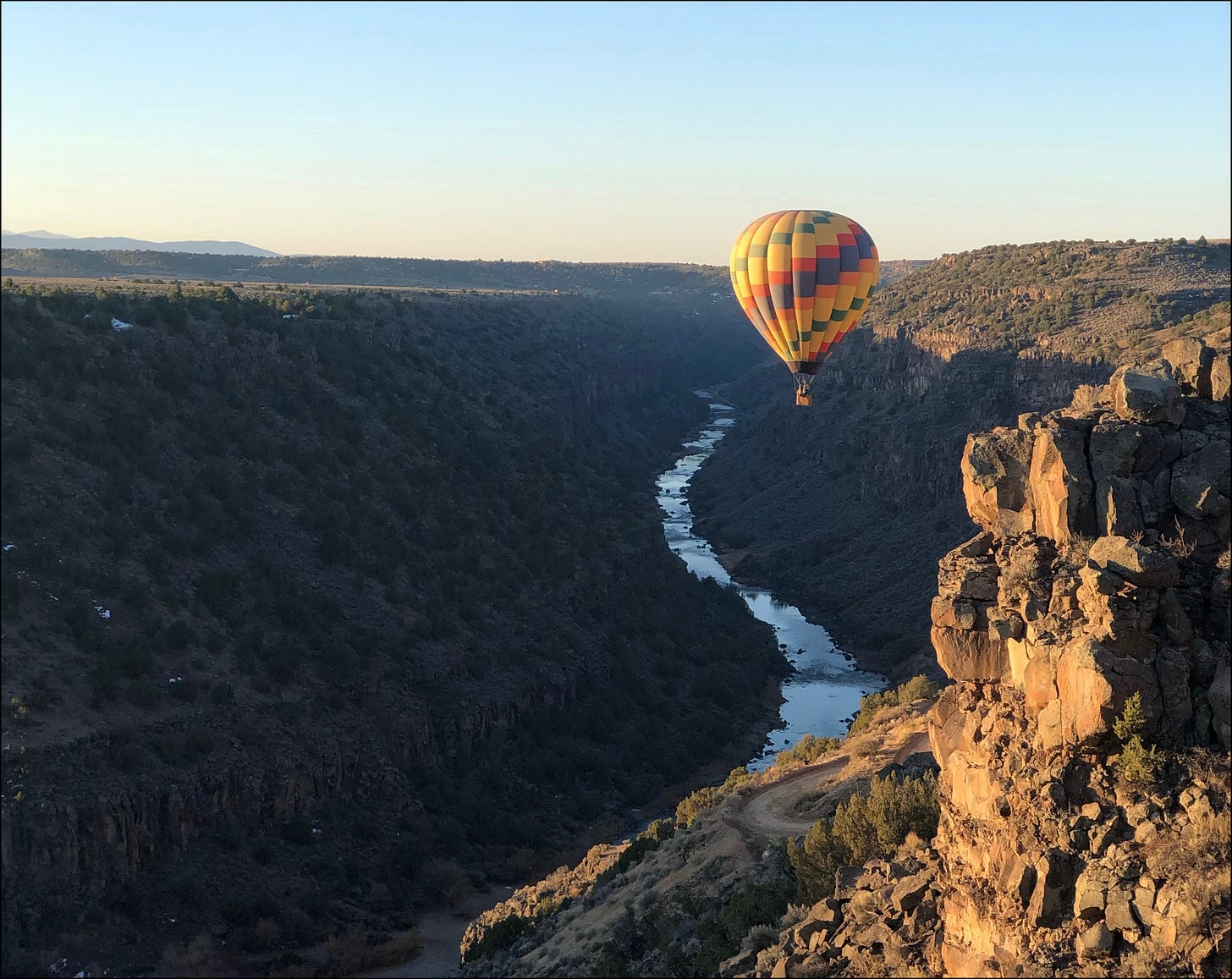Issue 001: Insert Tab, Get Decentralized
Let’s get this party rolling again yeah?
This issue’s theme is DECENTRALIZATION.
First we’ll hear from Priti Amin— top shelf science communicator—who will break down how psychedelics break down brain connectivity.
Next, the bard Aqueous regales a tale about coming-of-age, not of himself, but of something much larger.
We end, per usual, with some curated links and stellar tunes for your next flow state.
(FYI—email compression makes for poor images, highly recommend viewing in browser, see link at very top, or ‘Read in App’ button)
Let’s dig in 👽
Psilocybin desynchronizes the human brain
Breakdown by Priti Amin
Desynchronise… it's not a word I'd immediately associate with psychedelics.
Desynchronise… it sounds more like what my ballet teacher used to mutter while watching me attempt a pirouette – off-balance, out of sync, an epic fail of grace.
So when I came across a paper titled, ‘'Psilocybin desynchronizes the human brain” my interest was piqued. This word, at least on the surface, completely differs from the oft-cited “interconnected and unifying” experience of psychedelics.
But the paper revealed something else entirely. It wasn't the clumsy pirouette, or a descent into chaos, but a word that captured the nature of a flexible and dynamic state. I realised, sometimes a level of chaos needs to be injected into a system for radical change and innovation.
So… maybe ‘desynchronise’ does perfectly describes the essence of psychedelics. 🩰
Why they did it
Single, high doses of psilocybin (the magic in magic mushrooms) have shown great promise in clinical trials for providing long-lasting symptom relief in conditions such as depression, addiction, and anxiety.
If a heroic dose of shrooms can really one shot us into health, the question remains—what’s the mechanism? What is actually happening at the neurobiological level?

It is important to understand the mechanism of action of psychedelics because:
It can lead to better treatments: More precise dosing, targeted treatments, etc.
It can improve safety: Understanding the mechanisms can help identify and minimise potential risks.
It’s cool to tell people at parties
What they did
Onto the study design… although it may be tempting to skip over this part, let me briefly explain why, to a scientist, the study design is possibly the most important part of the paper. How trustworthy the results are can only be determined through careful dissection of how the study was conducted.
The Participants:
7 participants (aged 18-45)
All had prior experience with psychedelics but had abstained at least six months prior to the study
The Experimental Design:
Each participant received a 25 mg dose of psilocybin and an active placebo, on separate occasions, in a random order 💊💊
Study was double blinded—neither the participants nor researchers knew which dose was given in each session.
The active placebo, in this case ritalin, is a placebo that mimics some effects of psilocybin, like increased heart rate 🫀
This helps control for any indirect physiological effects of taking something, which may contribute to differences in brain activity, allowing researchers to tease out the direct effects of psilocybin on the brain.
Individual maps of brain connectivity (like a “brain fingerprint”) were captured using an fMRI scanner before, during and after the treatment 👇

What they found
They certainly did not bury the lede on this paper - the researchers found that psilocybin desynchronises the brain 🤯
Okay yes, but what’s that mean?
Basically, psilocybin drastically changes functional connectivity (FC) – the ways in which brain regions communicate with each other.
The researchers went so far as to describe the difference between a brain on psilocybin versus not as equivalent to the difference between the brains of two completely different people 👮♂️🧙♂️
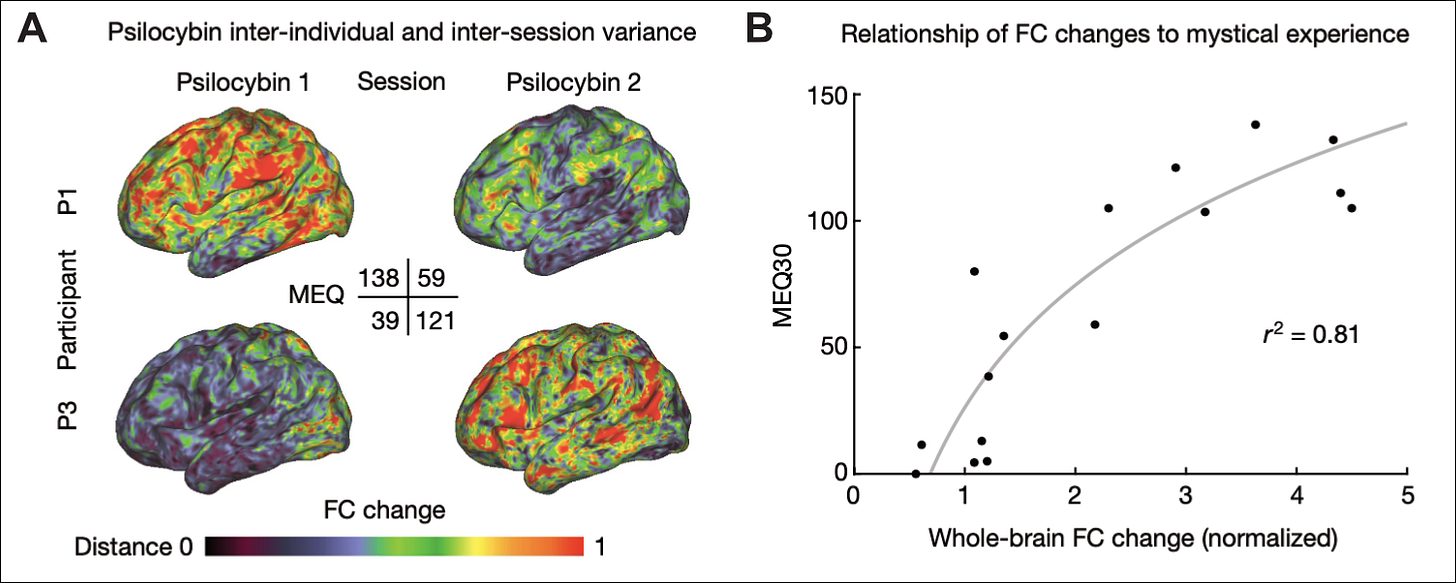
(A) Brain scans showing functional connectivity (FC) changes after two psilocybin doses in two participants. Red/yellow indicate increased FC, blue/purple indicate decreased FC. Participant 1 (P1, top) had high FC changes and a strong mystical experience (MEQ score) on the first dose (left) but not the second (right), while Participant 3 (P3, bottom) showed the opposite trend. (B) Across participants, greater whole-brain FC changes (bottom axis) correlate with higher MEQ scores, indicating a stronger mystical experience. The largest changes were observed in brain regions responsible for complex functions like reasoning and problem-solving
Researchers also observed major changes in the default mode network (DMN). The DMN is the part of the brain that coordinates our ‘internal narrative’, and is most active when daydreaming, mind-wandering, thinking about ourselves and our place in it all… 🔮
The DMN normally functions in an ‘anti-correlated’ manner, which means that increased activity in the DMN is consistently associated with decreased activity in another region, for example, circuits related to focus.
It appears that psilocybin reduces these anti-correlative couplings, disrupting the normal synchronous patterns of brain activity, causing the brain to become more desynchronised.
This is important, because it is believed that this synchronization is the basis of our perception and understanding of reality 👁️
But as is usual, data emerged that begs further questions:
Compare the experience of Participant 1 between two psilocybin dosing sessions.
Participant 1, Dosing Session #1:
Participant 1: “It was just like, well, awesome is a term that’s overused, but … that was just awesome. It was a sense of awe, a sense of brilliance.”
Researcher: “Feeling that you experienced something profoundly sacred and holy?”
Participant 1: “Five”
Participant 1, Dosing Session #2:
Participant 1: “The mystical divine experience of last time… no trace of that this time.”
This time Participant 1 rated ‘feeling that you experience something profoundly sacred and holy’ a zero.
Participant 1 received a 25mg dose of psilocybin twice (the second in a replication stage), but had two completely different experiences.
The first time around, the brain’s functional connectivity was dramatically desynchronised; the second time around, brain desynchronisation was minimal.
This demonstrates that brain desynchronisation is highly associated with having a ‘psychedelic’ experience.
Researchers tracked the participants FC over three weeks following their psilocybin dose, and found that it pretty much all returned to normal, with one exception—
FC between the anterior hippocampus (where personal experience and event memories are stored) and the DMN remained low - possibly representing a mechanism of long term benefits of psilocybin 📈
The researchers propose that reduced communication between the anterior hippocampus and the DMN may signal that pathways related to self-related memory systems are particularly malleable; a critical window of opportunity to reshape self-narratives
This could alter negative thought patterns and limiting beliefs, which is valuable for those dealing with challenges like depression and addiction 💜
Note from the author
Thank you for taking the time out of your day to learn some cool new science with me (I hope you didn’t read this before bed and will now spend the next 2 hours cogging over every detail of this paper like I have many times). This paper is a personal favourite for so (so, so, so….) many reasons. I love bridging spiritual concepts with science—it fills me with awe to see how ancient ideas and practices are finally being explained through physics, neuroscience, and everything in between. I also feel lucky to live in a time where we have the technology and brilliant minds to make these connections 🍄🟫 ❤️ 🧠
📃 Here’s the paper:
Siegel et al. Psilocybin desynchronizes the human brain. Nature. 2024 Aug;632(8023):131-138.
🧪 We appreciate your feedback on how we did breaking down the science. Let me know in the comments:
A Psychonaut's Path to PsyDAO
By: Aqueous
I remember my first psychedelic experience. College. A few close friends. Sounded fun. It kicked in, but everything just looked the same - my college dorm room was still my college dorm room, the elevator was still the elevator, and the river that ran outside was flowing southward like it did every day. Yet staring at my wall art, waiting in a tight metal box, or overlooking the Olentangy River felt different. Curious.
I remember scouring the internet, eager to find something validating my newfound curiosity. Erowid and its dark-web-esque UI. Phillocybin, The Crazy Engineer, Anarch_e. Anonymous usernames recollecting experiences so congruent to my own they became my friends. All underground. Secretive. Then there were the history lessons, the elders. Terrance McKenna, Alexander Shulgin, Gordon Wasson. They became my teachers, my idols.
I remember my first psychedelic conference: The Arizona Psychedelic Conference in 2019. Lawrence Laughing (aka Happy), the indigenous man who gave the opening remarks. Transpersonal psychology and neuroscience research. Dream studies. Dope merchandise. The networking social. I wore a purple patterned poncho. Invited to a sweat ceremony - a Temazcal. Do I go? Am I here for the research? For the culture?
I remember deciding to pursue my interests at University. Through student organizations, a community emerged on campus. SSDP. Decriminalize Nature. DanceSafe. Can I study Psychedelics - even major in it? Which professors will support me? A curriculum integrating social and life sciences. Real momentum. Entheogenic Science - that’s got to be the name. How could they refuse? They didn’t. A community forced underground, resurfacing.
I remember going on the road, seeking the community - the underground community. Moon ceremonies. Rainbow Festival. Nomads, buskers, hippies, and gypsies. The Green Wizard, Eagle, Boogie, and Willow. Vibrant thoughts and powerful convictions. Taos. The Earthship community. An immense archive of psychedelic history trapped in a filing cabinet.
I remember Wonderland Miami. The first psychedelic ‘business’ conference. What? The suits. The activists. The start-ups. People I’ve never heard of talking about a psychedelic panacea. Raising millions. Mike Tyson does frog venom? Cool. Ketamine, ketamine, esketamine!
I remember stepping away. Each path seemed a dead end to my ultimate desire: Facilitating space for a psychedelic community to exist, to thrive, and to progress. Everyone invited to turn on, tune in, or drop out as they desire.
I read research neglectful of the people and cultures who lit the psychedelic torch and kept it alive through prohibition. I saw communities struggling with set, setting, and dosage in an era of unregulated and untested substances. I met policy activists missing data to back their legislation and researchers restricted by fear-monger-driven policies. Moving above ground, pharma got involved and at one point tried to remove the ‘psychedelic’ experience from their analogous therapeutic drugs. I mean, come on broooooooo.
I went dormant for 3 years. But now I’m back.
Why? Because there’s a new model.
PsyDAO is a decentralized autonomous organization (i.e. DAO). Its purpose is to progress psychedelic science and art, and it does so by platforming its open community to make governance decisions on how DAO resources are allocated. Rather than a special few having vested interest in progressing (or inhibiting) psychedelic research, each member in the community acts according to their own vested interest.
The drug war never put an end to psychedelic science, it just created new conditions in which psychedelic science had to exist. The early internet (web1) was a decentralized tool for which, from these conditions, a true citizen science network of psychedelic research emerged. We now stand on the shoulders of these anonymous giants.
Now, we are above ground, the internet is ruled by oligarchs, and psychedelic research enterprises are increasingly siloed. PsyDAO simply asks the question: what if there was a different way?
What if psychedelic knowledge production was permissionless, but rewarded? Resource-driven, but community-governed? Tracked by ledger, but anonymous? Collaborative, but through community debate? What if anyone with an idea, initiative, and a community could access resources to see out their vision? These are questions PsyDAO is experimenting on, in pursuit of a different way.
I remember my past, I’ve studied our history, and I foresee a bright psychedelic future. The wisdom of the crowd is born out of the open competition of ideas. After all, it simply comes down to what our minds (psyche-) manifest (-delia).
Think more people should know about psychedelic science? Share our newsletter with your people, because your people are our people ✌🏽
From Around the Psychosphere
🔮 We are working on a lot at PsyDAO, but here are some particularly cool things we think you’ll be interested in:
We have a unique governance model based on the design principles of Elinor Ostrom’s Nobel-Prize winning work Governing the Commons.
We have a close partnership with KeneRAO and the Shipibo-Conibo tribe of Peru— we are bringing their art on chain, developing new value flows directly into the Shipibo community.
We are developing BeeARD (Bioeconomic Environment for Autonomous Research Discovery)
This is a multi-agent AI platform designed to accelerate scientific discovery, dealflow, streamline data analysis, and unlock fragmented datasets across scientific communities.
We are building OPSY (Open Psychedelic Science ecosYstem), a web3-native, open-access data collection platform that will utilize a token-for-data model to reward participants for contributing data.
Our goal is to both standardize and democratize data collection, platform governance, and access to psychedelic datasets.
We offer an Early Career Fellowship for Master’s, Ph.D., and Post Docs — our first fellow, Zeus Tipado, will be researching deoxymethoxetamine (DMXE). More on this from Priti here:
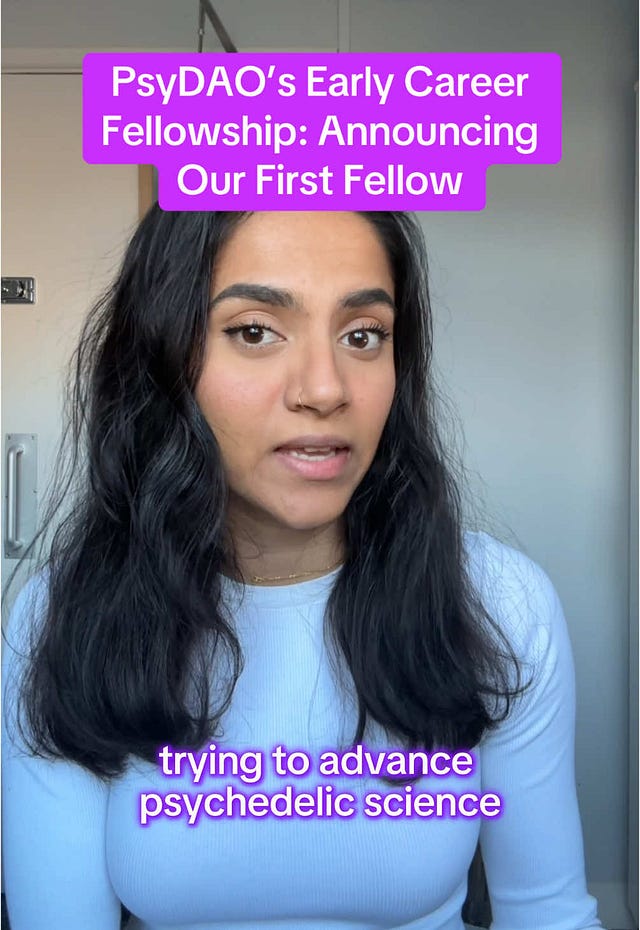 @psyyychedelicsPsyDAO’s Early Career Fellowship🚀🔬 The fellowship empowers undergraduates, master students, PhD students and postdocs looking to advance psych3d*lic science. PsyDAO supports fellows with funding, mentorship, and access to decentralised science (DeSci) tools. 🌍🔬 Meet our first fellow, Zeus Tipado, a PhD researcher pushing the boundaries of psychdlic research with VR, brain scans, and DMT studies! 🧠✨ Are you shaping the future of psych_d*lic science? Message us for more details on the fellowship! #psydao #desci #fellowship #funding #psychedelic #psychedelictok #psychedelicresearch
@psyyychedelicsPsyDAO’s Early Career Fellowship🚀🔬 The fellowship empowers undergraduates, master students, PhD students and postdocs looking to advance psych3d*lic science. PsyDAO supports fellows with funding, mentorship, and access to decentralised science (DeSci) tools. 🌍🔬 Meet our first fellow, Zeus Tipado, a PhD researcher pushing the boundaries of psychdlic research with VR, brain scans, and DMT studies! 🧠✨ Are you shaping the future of psych_d*lic science? Message us for more details on the fellowship! #psydao #desci #fellowship #funding #psychedelic #psychedelictok #psychedelicresearchTiktok failed to load.
Enable 3rd party cookies or use another browserFinally, we received a series of insanely cool funding applications from across the psychedelics landscape—PSYC members are voting this week on which to progress into dealflow, and those will ultimately be worked up into attractive powerhouse proposals to be voted on by $PSY holders. More soon 🧙♂️
Meanwhile explore all the PsyDAO links here, read our blog, join our Discord, and reach out here with any questions. Door’s always open ✌️
🍯 Tunes for your next flow state
This issue’s playlist provided by Warren— a couple tracks below, and full playlist here.
🤟🏽 Have a swell weekend friends 👽









